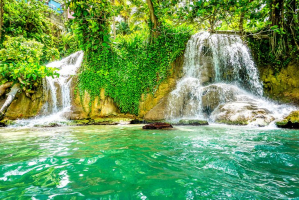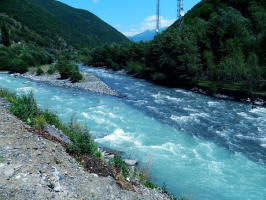Top 10 Longest Rivers in Angola
Angola is a country in Southern Africa with a diverse landscape that includes tropical Atlantic beaches, a maze of rivers, and a Sub-Saharan desert that ... read more...stretches into Namibia. Toplist has compiled the top longest rivers in Angola.
-
The first one in Top 10 Longest Rivers in Angola that Toplist would like to introduce to you is Congo River. The Congo River (Kongo: Nzâdi Kôngo, French: Fleuve Congo, Portuguese: Rio Congo), formerly known as the Zaire River, is Africa's second longest river, trailing only the Nile, and the world's second largest river by discharge volume, trailing only the Amazon. It is also the world's deepest recorded river, with depths exceeding 220 meters (720 ft). The Congo-Lualaba-Chambeshi River system is the world's ninth-longest river, with a total length of 4,700 km (2,920 mi). The Chambeshi River is a tributary of the Lualaba River, which is the name of the Congo River upstream of Boyoma Falls and runs for 1,800 kilometers (1,120 mi).
The Congo River has a total length of 4,370 km when measured with the Lualaba, its main tributary (2,715 mi). It is the only major river in the world that crosses the equator twice. The Congo Basin covers approximately 4,000,000 km2 (1,500,000 sq mi), or 13% of the total African landmass.
The Congo basin is notable for the lack of bridges that cross the main rivers, though there are a number of ferries that cross the Congo River and its major tributaries. The main reason is the narrowness of the Congo and main rivers, and the second is a lack of funds to build permanent river crossings.
Length: 4,700 km (2,900 mi- shared with Democratic Republic of the Congo and Republic of the Congo)
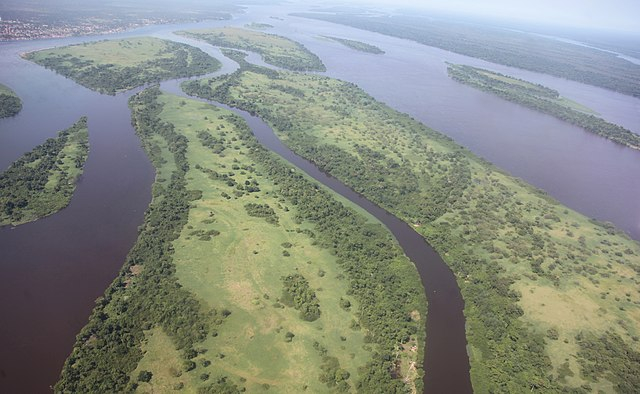
en.wikipedia.org 
tourcounsel.com -
The second one in Top 10 Longest Rivers in Angola that Toplist would like to introduce to you is Zambezi. The second longest river in Albania is Zamberi River. The Zambezi River (also spelled Zambeze and Zambesi) is Africa's fourth-longest river, its longest east-flowing river, and its largest river flowing into the Indian Ocean from Africa. Its basin is 1,390,000 square kilometers (540,000 square miles), which is slightly less than half the size of the Nile's. The river begins in Zambia and flows through eastern Angola, along Namibia's north-eastern border and Botswana's northern border, then through Zambia and Zimbabwe to Mozambique, where it crosses the country to empty into the Indian Ocean.
Victoria Falls is the most well-known feature of the Zambezi. Other notable falls include the Chavuma Falls on the Zambia-Angola border and the Ngonye Falls near Sioma in Western Zambia.
The river has two major hydroelectric power sources: the Kariba Dam in Zambia and Zimbabwe, and the Cahora Bassa Dam in Mozambique, which supplies power to Mozambique and South Africa. In Zambia, there are two smaller power stations along the Zambezi River, one at Victoria Falls and the other near Kalene Hill in Ikelenge District.
Length: 2,574 km (1,599 mi- shared with Zambia, Zimbabwe, Mozambique, Namibia and Botswana)
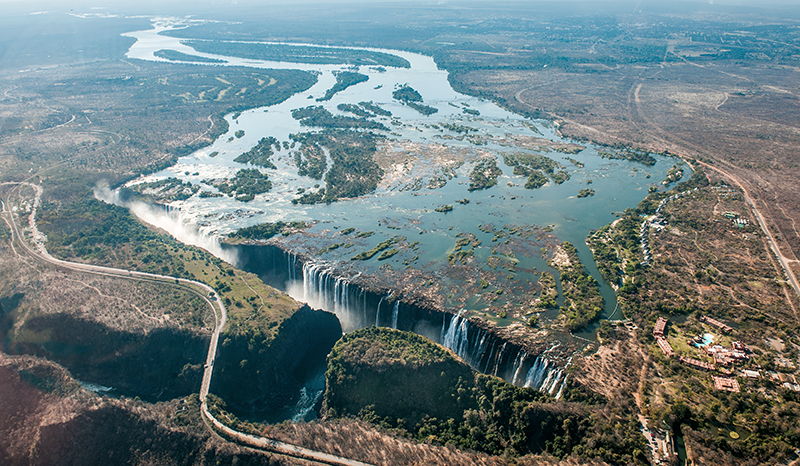
perspectives-cblacp.eu 
vi.wikipedia.org -
The third one in Top 10 Longest Rivers in Angola that Toplist would like to introduce to you is Kasai River. The Kasai River (Cassai in Angola) is a left-bank tributary of the Congo River in Central Africa. The river starts in central Angola and flows east until it reaches the border between Angola and the Democratic Republic of the Congo, where it turns north and serves as the border until it enters the DRC. The Kasai river turns west from Ilebo, between the confluences with the Lulua and Sankuru rivers. The lower stretch of the river from its confluence with the Fimi River until it joins the Congo at Kwamouth northeast of Kinshasa is known as the Kwa(h) River. The Kasai basin is primarily made up of equatorial rainforest areas that serve as agricultural land in a region known for its infertile, sandy soil. It is a tributary of the Congo River and contains diamonds. Around 60% of diamonds in Belgium are cut and shaped in the Kasai River.
On March 9, 1877, Henry Morton Stanley arrived at the confluence, calling the river Nkutu a "powerful and deep river," but recognizing it as originating from David Livingstone's Kwango.
Length: 2,153 km (1,338 mi- shared with Democratic Republic of the Congo)

en.wikipedia.org 
https://steemit.com/ -
The fourth one in Top 10 Longest Rivers in Angola that Toplist would like to introduce to you is Kwango River. The Cuango or Kwango (Portuguese: Rio Cuango) is a river that flows through Angola and the Democratic Republic of the Congo. It is the Congo River basin's largest left bank tributary of the Kasai River. It runs through Angola's Malanje. The Chitamba-Lulo Kimberlite Cluster in Lunda Norte Province has large diamond resources discovered in the main river channel and on flats and terraces in the flood plains of the Kwango River basin.
The Cuango River flows south–northwest from the highlands of Alto Chicapa in the Angolan province of Lunda Sul, crossing the border with the Democratic Republic of the Congo, and joining the Kasai River near Bandundo. Following that, it empties into the Congo River. The river forms a deep valley as it rises on the Lunda plateau.
It is 1,100 kilometers (680 miles) long from its headwaters to its confluence with the Congo River, with 855 kilometers (531 miles) in Angola. The river drains a catchment area of 263,500 square kilometers in total (101,700 sq mi). The Wamba and Kwilu rivers are its right bank tributaries.
The Cuango River has several falls and rapids. The river is mostly navigable in its lower reaches, which stretch 307 kilometers (191 miles) from its mouth to the Kingushi rapids. Partial navigation is also possible in the middle stretches of the river between Kingushi and the Franz Josef waterfalls, spanning approximately 300 kilometers (190 mi).
The river's lean season flow occurs in August. The average annual discharge in the river's lower reaches is 2,700 cubic metres (95,000 cu ft)/s.
Length: 1,647 ft (502 m- shared with Democratic Republic of the Congo )

vi.wikipedia.org 
pinterest.com -
The fifth one in Top 10 Longest Rivers in Angola that Toplist would like to introduce to you is Okavango River. The Okavango River (also known as the Okovango or Okovanggo River) is a river in southwest Africa. It is the fourth-longest river system in southern Africa, stretching 1,700 kilometers southeastward (1,100 mi). It begins at an elevation of 1,300 meters (4,300 feet) in Angola's sandy highlands, where it is known as Rio Cubango in Portuguese. It flows into Botswana from further south, where it forms part of the border between Angola and Namibia. The Okavango Delta lacks an outlet to the sea. Instead, it empties into the Okavango Delta or Okavango Alluvial Fan, a Kalahari Desert endorheic basin.
The upper reaches of the Cuito (an Okavango tributary river) in Angola are clogged due to controlled burns of vegetation, reducing water flow downstream as the accumulated water instead flows into the sand.
The river drops 4 meters before entering Botswana in a series of rapids known as Popa Falls, which are visible when the river is low, as it is during the dry season.
During the rainy season, an outflow to the Boteti River seasonally discharges to the Makgadikgadi Pans, which contain a large area of rainy-season wetland where tens of thousands of flamingos congregate each summer. A portion of the river's flow enters Lake Ngami.
Length: 1,700 km (1,100 mi-shared with Namibia and Botswana)
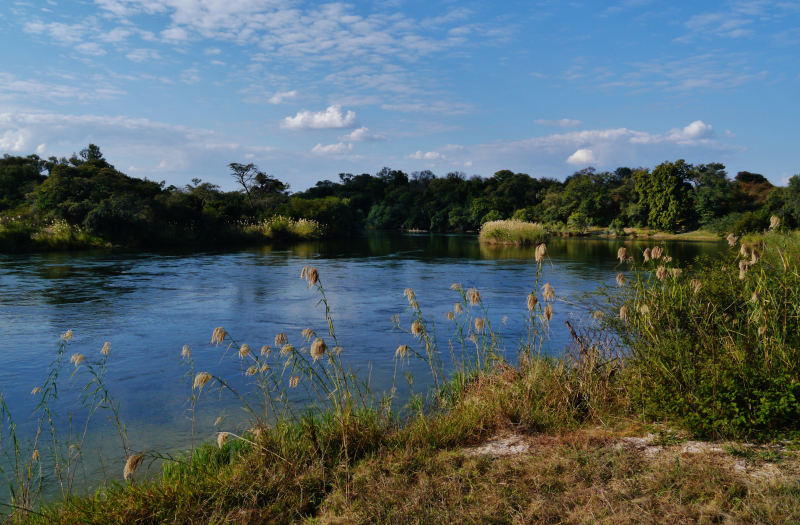
en.wikipedia.org 
whc.unesco.org -
The Cunene (Portuguese spelling) or Kunene (commonly used in Namibia) is a river in Southern Africa. It flows south from the Angolan highlands to the Namibian border. It then flows west along the border, eventually reaching the Atlantic Ocean. It is one of the region's few perennial rivers. It is approximately 1,050 kilometers (652 miles) long, with a drainage basin area of 106,560 square kilometers (41,143 square miles). Its mean annual discharge at its mouth is 174 m3/s (6,145 cfs). The Epupa Falls are located on the river. The Olushandja Dam dams a tributary of the river, the Etaka, and provides water to the Ruacana Power Station.
Tourists visit Epupa campsites or lodges that offer river water sports such as rafting and canoeing. There are ancient baobab trees alongside the gorge, as well as an attractive and well-kept viewpoint high above the village and falls, but both are marred by broken bottles and an abundance of garbage.
Length: 1,050 km (650 mi- shared with Namibia)

flickr.com Video: Cunene Angola's Youtube Channel -
The Kwanza River, also known as the Coanza, the Quanza, and the Cuanza, is one of Angola's longest rivers. It empties into the Atlantic Ocean just south of Luanda, the country's capital. The river is navigable for approximately 150 miles (240 kilometers) from its mouth, which is located 60 kilometers (37 miles) south of Luanda. The Cutato and Lucala were among its tributaries.
The navigable lower course of the river was the original route of Portugal's invasion into northern Angola.
In 2004, the Capanda Dam in Malanje Province was completed, providing hydroelectric power to the region and assisting with irrigation. The Cambambe Hydroelectric Power Station is also located on the river, and the Lauca Dam is currently under construction. The river's mouth, Barra do Kwanza, is gradually being developed for tourism, including a golf course.
According to research published on the Science and Development Network website, the Angolan river has a high biodiversity. So far, Angola's first biodiversity survey of the Kwanza River has discovered 50 fish species. Genetic testing, according to researchers from the National Fishing Research Institute and the South African Institute for Aquatic Biodiversity, may reveal new species. Tarpon is a sportfishing species.
Length: 960 km (600 mi)

en.wikipedia.org 
angolafieldgroup.com -
The Lungwebungu River (Lungué Bungo in Angola) is the largest tributary of the upper Zambezi River in south-west-central Africa. The Lungwebungu has its headwaters in central Angola at an elevation of around 1,400 meters (4,600 feet), and it flows south-east across the southern African plateau. Within 50 kilometers (31 miles), it has developed the character that it retains for the majority of its course, of extremely intricate meanders, with multiple channels and oxbow lakes, in a swampy channel about 800 m (2,600 ft) wide, which is in turn in a shallow valley with a floodplain 3 to 5 km (1.9 to 3.1 mi) wide, inundated during the rainy season. The floodplain's edges are a white sandy soil covered in a thin forest. The main river channel widens from 50 m (160 ft) to 200 m (660 ft) near the Zambezi, and its floodplain suddenly broadens as it merges with the Zambezi, forming the Barotse Floodplain, which is 25 km (16 mi) wide at that point.
While the river is a valuable resource for people who live nearby as a source of fish, its meanders make it unsuitable for water transport except during the rainy season, when canoes and small boats can ride the flood.
Length: 644 km (400 mi- shared with Zambia)

flickr.com 
flickr.com -
The Cuvo River runs through central Angola. The river empties into the Atlantic Ocean at Benguela Bay, in the province of Cuanza Sul. In its upper reaches, it is known as the Cuvo; in its lower reaches, it is known as the Keve or Queve. Upstream, the river can be navigated to Binga Falls near Gabela. The Cussoi River is one of its main tributaries.
The river may be the southern limit of the African manatee's range. The African manatee (Trichechus senegalensis), also known as the West African manatee, is a manatee species that lives in much of western Africa, from Senegal to Angola. It is the only species of manatee found in the Old World. The river wetland floodplain and Kumbira Forest are both part of an Important Bird Area that is home to several rare species. An Important Bird and Biodiversity Area (IBA) is a location that has been identified as being globally important for the conservation of bird populations using an internationally agreed-upon set of criteria. BirdLife International created IBAs and identified sites.
A mangrove forest grows near the river's mouth.
Length: 505 km (313 mi)

en.wikipedia.org 
pinterest.com -
The Chiloango River (Portuguese: Rio Chiluango, also known as the Kakongo River, the Louango River, the Shiloango River, and the Rio Hi River) is a river in western Central Africa.
It forms the westernmost part of the border between the Democratic Republic of the Congo and the Republic of the Congo, and then roughly half of the border between the DRC and Cabinda, Angola, passing just south of Necuto- Angola's city and commune, located in the province of Cabinda. The river then cuts through Cabinda, making it the province's most important river.
It empties into the Atlantic Ocean just north of Cacongo. With an area of approximately 106,460,000 km2, the Atlantic Ocean is the second-largest of the world's five oceans (41,100,000 sq mi). It covers approximately 20% of the Earth's surface and approximately 29% of its water surface area. In the European perception of the world, it is known to separate the "Old World" of Africa, Europe, and Asia from the "New World" of the Americas.
Length: 160 km (90 mi)

https://welcometoangola.co.ao/ 
Video: Russell Tate's Youtube Channel














